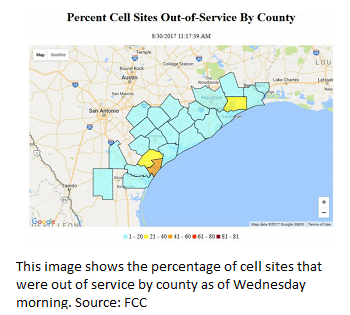
As the rain was starting to lessen in areas of Southeast Texas initially impacted by Tropical Storm Harvey, carriers reported few cell tower sites out of commission on Wednesday. Of the 55 impacted counties in Texas and Louisiana, 4.2 percent of the cell sites were out of service, down from 4.7 percent on Tuesday, according to the FCC’s Disaster Information Reporting System (DIRS).
For the first time since the FCC began issuing daily communications outage reports for Harvey, there were no counties with more than 50 percent of sites out of service. Aransas and Refugio were both above 50 percent on Tuesday, but dropped from 84.2 percent to 47.4 percent and from 73.1 percent to 26.9 percent, respectively. There were no cell sites reported out of service in Louisiana. That, too, is an improvement. On Tuesday, Calcasieu, St. John the Baptist, and Terrebonne parishes each reported one site out. Continue Reading















